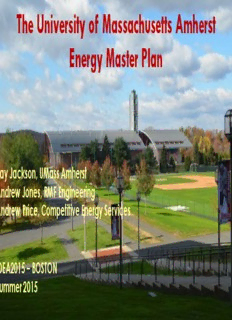
UMass Amherst Energy Master Plan PDF
Preview UMass Amherst Energy Master Plan
The University of Massachusetts Amherst Energy Master Plan Ray Jackson, UMass Amherst Andrew Jones, RMF Engineering Andrew Price, Competitive Energy Services IDEA2015 – BOSTON Summer 2015 Agenda Campus Master Plan and need for a Utility Master Plan • Overview of the Energy Master Plan Process • Findings from the Process • Energy Master Plan Recommendations • Meeting EO484 Goals • UUMMAASSSS campus planning AAMMHHEERRSSTT 2006-2011 – 937,402 gsf added to Campus 2011-2014 – 1,070260 gsf added to Campus Beginning to tax utility systems, both internally and regionally Losing N+1 capacity for steam generation and electrical capacity UUMMAASSSS campus planning AAMMHHEERRSSTT Existing program (2010) Campus Total GSF 10.8M GSF This space can accommodate approximately: • 24,300 Students • 8,000 Faculty/Staff • 12,500 Beds 4% Garages 34% 18% Admin Academic 6% Student Life 6% Recreation 32% Residential UUMMAASSSS campus planning AAMMHHEERRSSTT Near Term Plan Program Campus Total GSF 12.5M GSF This space can accommodate approximately: • 27,700 Students • 8,800 Faculty/Staff • 14,000 Beds 5% Garages 16% Admin 37% Academic 6% Student Life 6% Recreation 31% Residential UUMMAASSSS campus planning AAMMHHEERRSSTT Long Term Accommodation (50 Years) This space can accommodate approximately: • 36,700 Students • 11,700 Faculty/Staff • 19,000 Beds Campus Total 18.2M GSF 7% Garages 39% 11% Admin Academic 5% Campus Life 6% 33% Recreation Residential UUMMAASSSS campus planning AAMMHHEERRSSTT Campus Energy Master Plan: Request for Proposals Goal of Energy Master Plan: “To develop a plan for the reliable delivery of energy at University of Massachusetts Amherst over the next 30 years and to define and prioritize categories of projects to achieve the most transformative effect on current and future energy consumption at the UMA Amherst campus at the minimum cost and with the highest measure of greenhouse gas emission reduction.” • Overview of Existing Campus Energy Systems • Challenges/Opportunities Created by Physical Master Plan • Commitment to Sustainability • Inventory/Discovery • Analysis/Assessment • Alternatives/Implementation Needed Information for the development of Capital Plan UUMMAASSSS campus planning AAMMHHEERRSSTT Campus Energy Master Plan: Steering Committee & Stakeholder Group Physical Plant Stakeholder G roup Ray Jackson, Director Physical Plant Juanita Holler, Assoc. VC, Facilities & Campus Services Jeff Bryan, Assistant Director, Utilities Dennis Swinford, Director, Campus Planning Steve Grden, Utility Electrical Engineer Tom Shaw, Director, Design and Construction Management Jason Burbank. Campus Energy Engineer Sandy Beauregard, Controls Specialist Ray Jackson, Director, Physical Plant Design and Construction Management Jeri Baker, Director, Transportation Services John Matthews, Assistant Director, Campus Projects Shane Conklin, Director, Administrative Services Ted Mendoza, Capital Projects Manager Andy Mangels, VC Finance & Budget Director Jason Venditti, Capital Projects Manager Eddie Hull, Exec. Director of Residential Life Campus Planning Niels la Cour, Senior Physical Planner Ken Toong, Exec. Director, Auxiliary Enterprises Ludmilla Pavlova, Senior Facilities Planner Dan Markowski, Assoc. Athletic Director, Facilities/Operations Administrative Services Will Shea, Director, Finance & Cost Analysis Shane Conklin, Director Ezra Small, Sustainability Manager, Physical Plant Competitive Energy Services Professor John Collura, Assoc. Dean of College of Engineering Andrew Price Craig Nicolson, Sustainable Science Program Director Keith Sampson Ben Weil, Assistant Professor, Environmental Conservation Zac Bloom UUMMAASSSS campus planning AAMMHHEERRSSTT Campus Energy Master Plan Process 1. Develop a thorough understanding of existing utility systems • Reliability limitations • Efficiency • Capital renewal requirements 2. Evaluation of replacement and expansion options • Future campus growth • Life cycle cost analysis and comparison • Feasibility assessment (operational, sustainability, etc…) 3. Implementation plan • A utility project list synchronized with the 10-year campus plan • A schedule of funding requirements • A benchmark of current efficiencies with future milestones UUMMAASSSS campus planning AAMMHHEERRSSTT Summary of Energy Challenges Fiscal Year 2014 Natural gas* 1,700,000 Million Btu’s $16.4 M/yr Liquid natural gas 194,000 Million Btu’s $4.6 M/yr Oil 96,000 Million Btu’s $2.4 M/yr Electric Purchased 150,000 Million Btu’s $6.0 M/yr TOTAL 2,140,000 $29.4 M/yr Million Btu’s * Includes fuel for on-site cogeneration Utility infrastructure is a significant asset (value ~$800 M) • Campus operations rely upon uninterrupted utility services • Goals to reduce energy use, fuel costs and carbon footprint • Need to support future expansion • UUMMAASSSS campus planning AAMMHHEERRSSTT
Description: